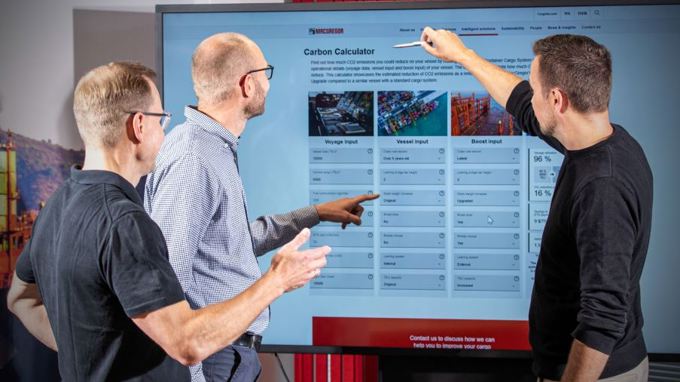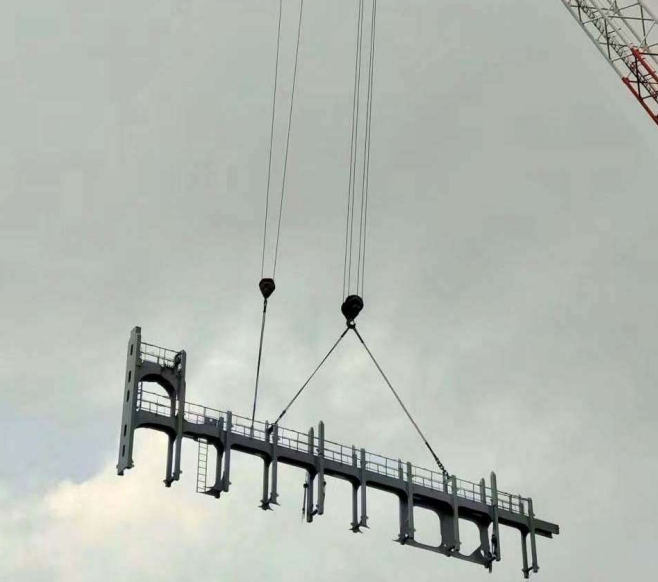Opening eyes for inefficiencies

HANSA - International Maritime Journal 02/2025
By Michael Meyer
Read original article
With its new Carbon Calculator, cargo handling specialist MacGregor aims to provide shipowners with arguments for increasing cargo capacity and modernising equipment. Demand is likely to increase in view of developments in the global fleet.
It all started with a practical experience of a seafarer and a rather simple but fundamental insight: there are significant inefficiencies on board container ships when it comes to the utilisation of cargo capacity. This is turn has an impact on the environment. Because fewer containers on board than possible means more emissions per transported cargo.
"A captain who now works for us used to sail on container ships. And he saw that they couldn't load them full. And when he started working with us, he began to realise what the reason was," says Arto Toivonen, container expert and sales manager for loose lashing and "Cargo Boost" (we come back to this later), explains.
"Usually a randomly chosen container ship can carry about 80% of her informed theoretical TEU-capacity. It is possible to riase utilisation percentage from 80% to close to 100% in some cases, but typically 90% is a good target when starting the project", MacGregor states.
The company's experts have therefore developed the Carbon Calculator which is now available online free of charge. The tool can help enhancing cargo loading efficiency by self-assessing the environmental impact of cargo upgrades.
"That is our take on the cargo system development and sustainability: that we first try to open the eyes, to see that the asset is not effective", Toivonen adds. After that, shipowners can go on and check what can be done by making changes or adaptations to a number of specific parameters. Toivonen says: "Ship owners know that their vessels are not very cargo effective. But the next question is: What can you do?"
Container ships' cargo system consists of hatch covers, lashing bridges, lashing, cell guides, deck stanchions and container fixed fittings. Having a more efficient cargo storage management and enhancing cargo volumes can imporve efficiency because the more containers you have on board one vessel, the better the environmental footprint per TEU you get.
"For example, you can enter the size and main haul lines of the vessel as well as the fuel consumption, ETS costs, stowage options, lashing bridge tier height, stack weight lashing systems, "Mickey Mouses" (the latter being towers on the wind-exposed outermost rows of lashing bridges which make it possible to add additional tiers of containers). As a result, you can see your improved utilization rate, savings in ETS payments and in fuel costs - and in the end an additional revenue", the expert explains.

Arto Toivonen, container expert and manager for loose lashing and "Cargo Boost"
The business model?
An easy-to-use tool free of charge, with no direct revenue for MacGregor... So what is the business model behind it? On the one hand, there is the somewhat idealistic argument: protecting the environment: "This isn't just another product - it is a commitment to a sustainable future for our planet. Whether or not the user chooses to partner with us, our motivation remains the same, a common interest in protecting our one, shared planet, MacGregor states.
"However, at the same time, we and our customers have to make money", Toivonen emphasizes. The plan is that shipowners, when recognizing the potentially significant benefits, will decide to either retrofit existing vessels or even choose MacGregor efficiency-enhancing products for newbuilding projects.
In that sense, the carbon calculator can be seen as a potential driver for MacGregor's "Cargo Boost". Customers can use the carbon calculator and check their cargo efficiency without calling MacGregor. However, they can do so it if they want to go on with changes or adaptations. Then more calculations and checks are done to see what it would cost to enhance efficiency. For example, options include lashing bridge elevation, changing from internal to external lashing, Mickey Mouses for better stack weight distribution or boltable ISO gap adapters for mixed stow and trim handling.
It was already a couple of years ago when MacGregor started "Cargo Boost" for this business activity - meaning an offer for cargo system upgrades, be it with equipment or paperwork or other services. The company calculates that its own Cargo Boost solution could reduce the environmental footprint of container shipping by more than 10%.
"At the simplest level", significant improvements can be achieved by what MacGregor describes as a "paper exercise", scrutinising the vessel's Cargo Securing Manual to determine where gains can be made by updating to the latest class rules, which are often more sympathetic to increased payloads. Also maximum container stack weights can be increased by the paper exercise only, which further boosts the benefits gained from the latest class rules. MacGregor says that hundreds of vessels have benefitted from this service alone without any physical alterations to the vessel.
And, having in mind current and upcoming environmental regulations, does he see a growing demand from ship owners or characters for cargo boost activities as vessels need to get more efficient until new vessels will come to the market? "Yes, there are some aspects we can see: when we started doing these cargo system upgrades around 2017, we saw big shipping lines wanting to upgrade their own fleet. And they did many projects. Then, in the last 1-2 years, we have seen that now the liners start to also upgrade the cargo systems on their charter fleet". Not least, nowadays sustainability has a much higher relevance for shipping companies, and they spend bigger budgets for such upgrades. Therefore, Toivonen agrees that this kind of activity will potentially even grow further as regulatory pressure is growing.
Besides retrofit measures, another option for the fleet could be to look more on cargo efficiency during the design phase of a vessel. Owners sometimes pay insufficient attention to the vessel's cargo-handling system during the early design stage, MacGregor says, adding: "If the owner wants to rectify this at a later stage, it will cost them a lot of time and money. Taking a holistic view of the cargo-handling system and its desired capabilities in the early design process pays off in the future."
"Ship owners and yards are doing a lot of good things to reduce their vessels' environmental footprint, such as adopting digital tools for more efficient route planning and optimising hull forms for reduced friction," says Toivonen. "However, what tends to be overlooked is the extent to which a carefully conceived stowage system can contribute to ESG agendas."
"Eventually, we will reach the point where incremental performance enhancements are no longer enough to maintain regulatory compliance, and ship owners will simply have to make the switch to greener fuels," he says. "Optimised cargo handling will help them to offset the significant costs involved while compensating somewhat for the reduced hold space resulting from more complex fuel-storage requirements."

Cargo loading equipment - the business model of MacGregor